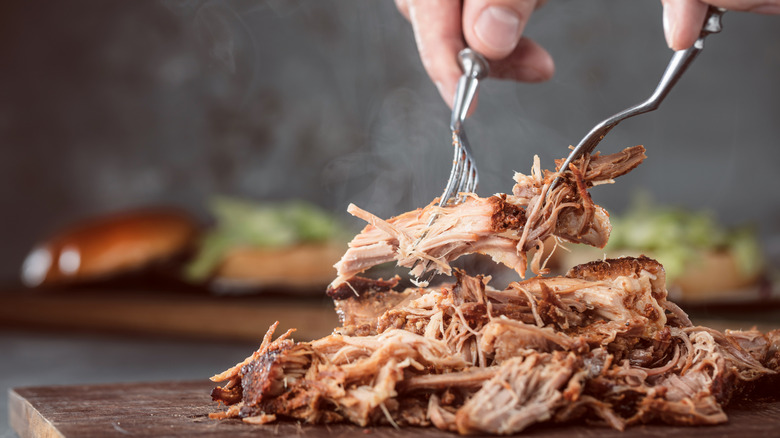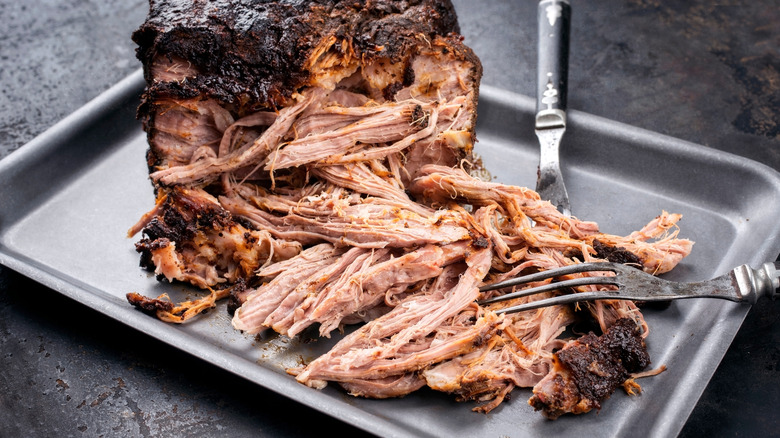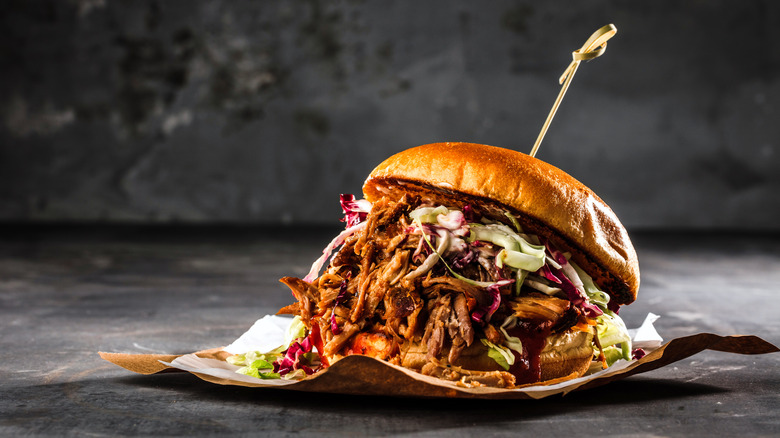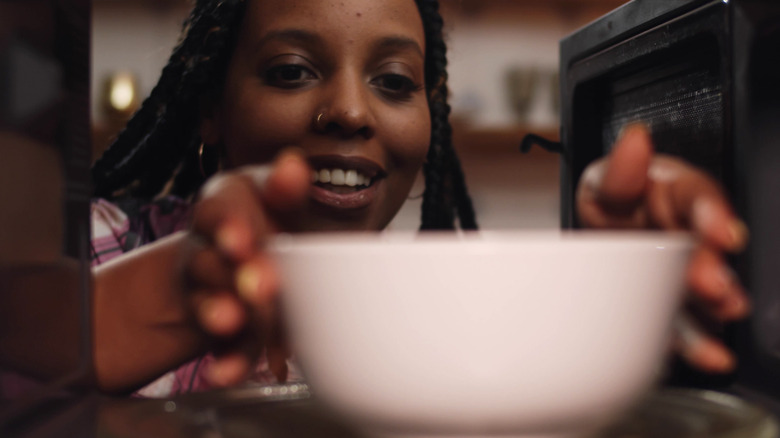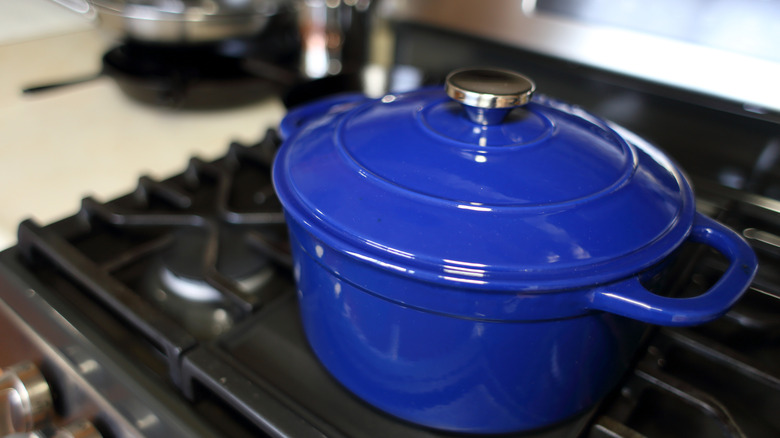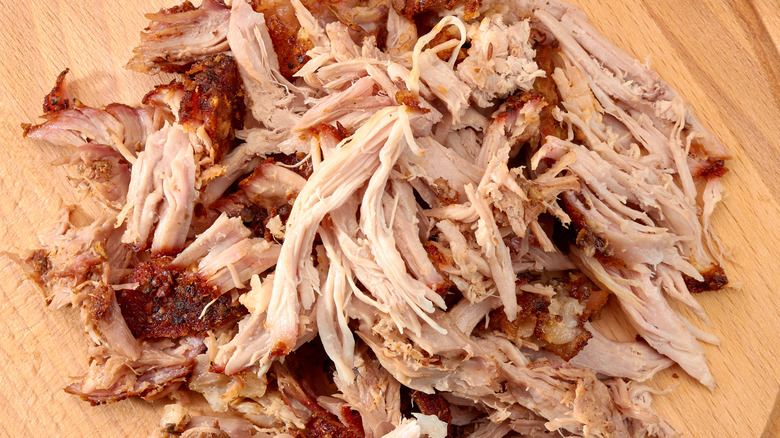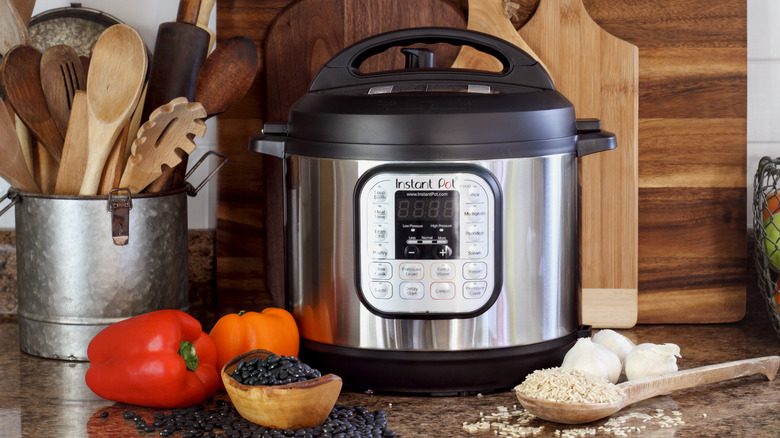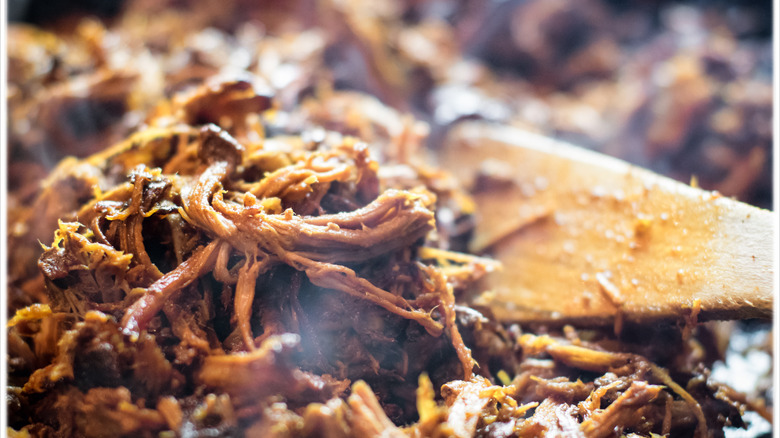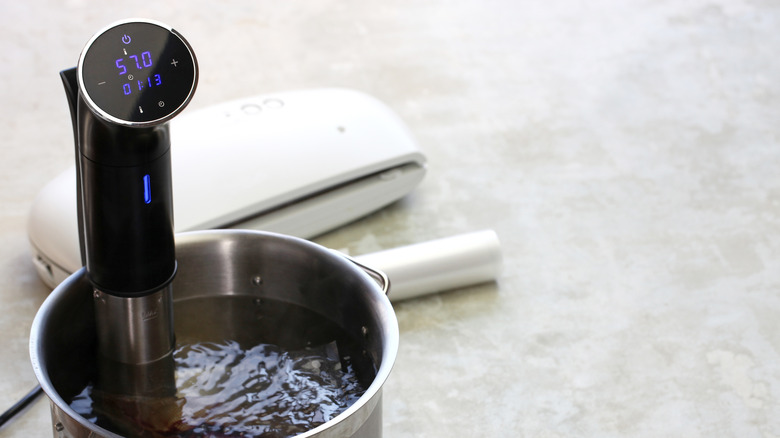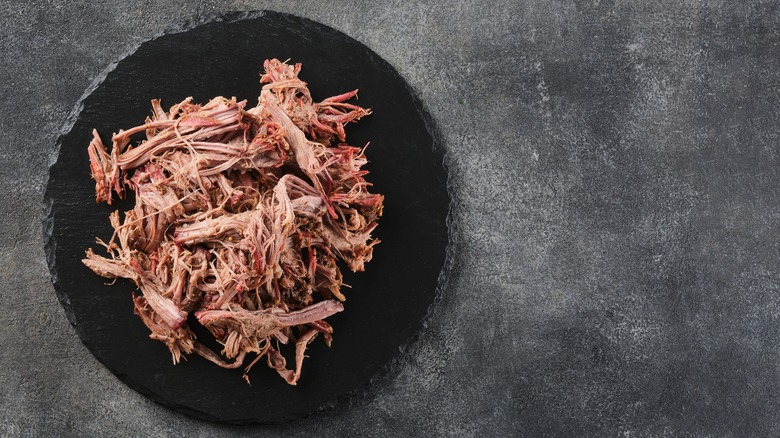Here's How You Should Be Reheating Pulled Pork
If you love barbecue, chances are you've eaten your fair share of pulled pork. Typically made from the shoulder of a pig, pulled pork is a common barbecue dish that's usually smoked low and slow and cooked until falling-apart-tender in a low oven or slow cooker. Very often coated with a dry rub before cooking and then mixed with any number of a variety of barbecue sauces after shredding, pulled pork is delicious piled onto a sandwich or alongside comfort food side dishes such as mac and cheese, baked beans, and coleslaw.
If you've ever made pulled pork at home, you know this dish produces a lot of leftovers. Pulled pork is typically made with a whole shoulder weighing between 12 and 16 pounds, so even after your family and friends have chowed down, you'll likely have some extra meat to tuck away into the refrigerator. Whether your leftovers are to-go from your favorite BBQ spot or from your own home cooking, these are some ways you can reheat this tasty meat — without running the risk of drying it out.
In the oven
When faced with a pileup of leftover pulled pork, one excellent way to reheat it is in your oven. By setting the oven to a low temperature and adding a little liquid back into the meat, you'll essentially steam it under a layer of tinfoil, which will keep it nice and moist.
To reheat pulled pork in the oven, preheat the oven to 225 degrees Fahrenheit. Spread your leftover pork into the bottom of a glass or ceramic baking dish, add a splash of leftover barbecue sauce, broth, apple juice, or other flavorful liquid, then cover the pan tightly with a layer of tinfoil. Cook until the meat reaches an internal temperature of 165 degrees when checked with a meat thermometer, or about 30 minutes. Before serving, peel back foil, being careful of the steam inside, give the meat a stir, and then enjoy your pulled pork leftovers.
In the toaster oven
If you only need to reheat a small portion of leftover pulled pork — say, for piling onto a sandwich or tucking inside an omelet — you can use your toaster oven instead of your oven.
Since a toaster oven is just a small version of an oven, the method here is almost exactly the same as reheating in a large oven. Preheat the toaster oven to 225 degrees Fahrenheit, place some leftover pulled pork into the bottom of a small baking dish, add a splash of leftover barbecue sauce, broth, apple juice, or other flavorful liquid. Cover the dish tightly with foil, and cook until the meat reaches an internal temperature of 165 degrees when checked with a meat thermometer, or about 30 minutes. As with a regular oven, peel back the foil, being careful of the hot steam inside, give the meat a stir, and then enjoy your leftover pulled pork.
In the microwave
While the microwave can be notorious for drying out certain foods (like a rare steak or a delicate pastry), leftover pulled pork is actually a good candidate for microwave reheating because it already contains quite a bit of moisture in it, which will help keep the meat tender as it reheats.
To reheat leftover pulled pork in the microwave, place it into a microwave-safe dish, add a splash of leftover barbecue sauce, broth, apple juice, or other flavorful liquid, cover it tightly with the dish's lid or with plastic wrap, and nuke the pulled pork on high for about two minutes, or until it reaches an internal temperature of 165 degrees when checked with a meat thermometer. Make sure to give the meat a stir before serving, to distribute the heat evenly, then enjoy your pulled pork leftovers.
On the stovetop
If you want to reheat your leftover pulled pork on the stovetop, you're in luck: This is a dish that takes quite well to reheating in a pan. As with the above methods, the secret to reheating pulled pork on the stovetop is locking in moisture, so as to ensure that the shredded meat doesn't dry out and get tough. To do so, we recommend you pile leftover pulled pork into a Dutch oven or heavy-bottomed skillet, add a splash of leftover barbecue sauce, broth, apple juice, or other flavorful liquid, and cover the pan tightly with its lid.
Heat the pan over low-to-medium heat, taking the lid off occasionally to stir the pulled pork around, until the meat reaches an internal temperature of 165 degrees Fahrenheit when checked with a meat thermometer, or about 12 to 15 minutes. If the meat begins to dry out, add another splash of liquid.
In the air fryer
If you're one of those cooks who loves to make everything in your air fryer, you're not alone. According to Taste of Home, the gadget has grown in popularity over the past few years, with nearly 40% of U.S. homes possessing one as of July 2020. And the air fryer isn't just for cooking, but for reheating, too.
If you want to use the appliance for reheating your leftover pulled pork, we recommend placing one portion of leftover pulled pork into a ceramic ramekin, adding one tablespoon of leftover barbecue sauce, broth, apple juice, or other flavorful liquid, and repeating the process in three more ramekins. Place the ramekins in the air fryer and cook for six minutes at 320 degrees Fahrenheit. If the pulled pork releases a lot of liquid, you can drain it off and mix in a little more BBQ sauce before serving.
In the Instant Pot
If you're the owner of an Instant Pot, you probably already know that it's a wonderful tool for reheating items ranging from soup, to rice, to mashed potatoes. Since the pressurized pot is so good at locking in moisture, it's an excellent choice for reheating leftover pulled pork.
To reheat pulled pork in the Instant Pot, first place the insert pot into the machine, add a small amount of water to the pot, and place the trivet inside. Place a portion of leftover pulled pork into a heat safe dish, then place the dish on top of the trivet inside the Instant Pot — no cover needed. Close the Instant Pot with its lid, select the steam function for five minutes, then open the pot either by quick release or by natural release. Check the pork for an internal temperature of 165 degrees Fahrenheit, and if it isn't warm enough, steam it for an additional minute or two before serving.
In the slow cooker
If you prepared your pulled pork at home in a slow cooker or crockpot, you can use the same machine to reheat any leftover meat — as long as you've got some time to plan ahead. The slow cooker method is an excellent one for reheating leftover pulled pork, but it does take some time — plan on between two and four hours.
To reheat leftover pulled pork, spread it into the bottom of the slow cooker or crockpot, add a splash of leftover barbecue sauce, broth, apple juice, or other flavorful liquid, set the crockpot to warm, and allow it to heat for a minimum of two and up to four hours. Before serving, check the pork for an internal temperature of 165 degrees, mix in a little additional barbecue sauce, if you want to, then enjoy your leftover pulled pork.
Sous vide
If you have the equipment to reheat sous vide you can store your leftover pulled pork in a vacuum-sealed bag and have delicious, moist pork with minimal effort. Sous vide translates as "under vacuum" in French and involves submerging the sealed bag of food and evenly heating the bag with constant, circulating water that is regulated at the same temperature.
To sous vide leftover pulled pork, heat the water to 165 degrees Fahrenheit and then submerge your bag for 45 minutes per inch of thickness of the bag. So if your bag is 1 inch thick, you'll heat your pork for 45 minutes, 2 inches means you'll heat it for 90 minutes. You can also sous vide leftover pulled pork from frozen. The vacuum seal bags help protect your leftovers from freezer burn and preserve the life of your leftovers for longer. If you choose to sous vide from frozen you'll need to add an additional 30 minutes to your pork. A bonus of sous vide is you won't need to add any additional moisture to your pork and this method will keep your leftovers succulent and tender.
On the grill
The grill can be a great tool for helping pulled pork retain its smokey, depth of flavor. To reheat pulled pork on the grill most effectively you'll need to utilize a two-zone cooking process. A two-zone cooking process on your grill is when you keep one section of your grill at a high temperature and another section with no heat. This gives you more control of the cooking temperature for reheating your pork.
Once the side of your grill that uses indirect heat reaches 225 degrees Fahrenheit, you're ready to start reheating. Using completely thawed pulled pork, you'll want to wrap your leftovers in a couple of layers of aluminum foil and cover your pork in BBQ sauce for extra flavor and moisture retention. You can also heat it in a covered, grill-safe pan. You'll heat your pulled pork on the indirect heat side of your grill to start. After the pork reaches a temperature of 165 degrees Fahrenheit, you have the option to uncover the pork and place it on the heat side in a pan to quickly add some crispy bits.
